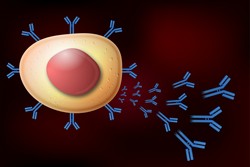Asymmetrical B cell division during activation
B cell activation is initiated by antigen recognition through the B cell receptor (BCR) and subsequent internalisation of antigen for presentation to T cells. Activation leads to proliferation and differentiation into plasma cells or memory B cells. Recent theory highlighted the unequal inheritance of antigen between daughter cells due to rapid antigen compartmentalisation that is maintained during B cell division. This abolishes the uniform distribution of antigen vesicles between daughter cells, generating two different B cells. The overall aim of the EU-funded ASYMMETRY IN B CELLS (Asymmetrical B cell division: origin and functional significance) project was to understand how antigen polarity is established and maintained, and what is the functional meaning of this asymmetry. Researchers developed state of the art techniques to quantify antigen polarity in B cells using confocal microscopy, flow cytometry and Image Stream. Microtubules and protein kinase C (PKC) beta were identified as the key elements in the establishment of polarity in B cells. The polarity was essential to achieve a productive immune response, namely antigen presentation to T cells and the initiation of the germinal centre reaction. Importantly, the PKC beta additionally controlled the appearance of antibody producing cells (plasma cells) independently of antigen polarity. The important results from this project have contributed to the general knowledge of immunological responses and explained how PKC beta plays its role in the emergence of the various B cell populations. Considering that PKC beta is implicated in several types of cancer, the outcome of the project has an impact on the future clinical cancer studies.



